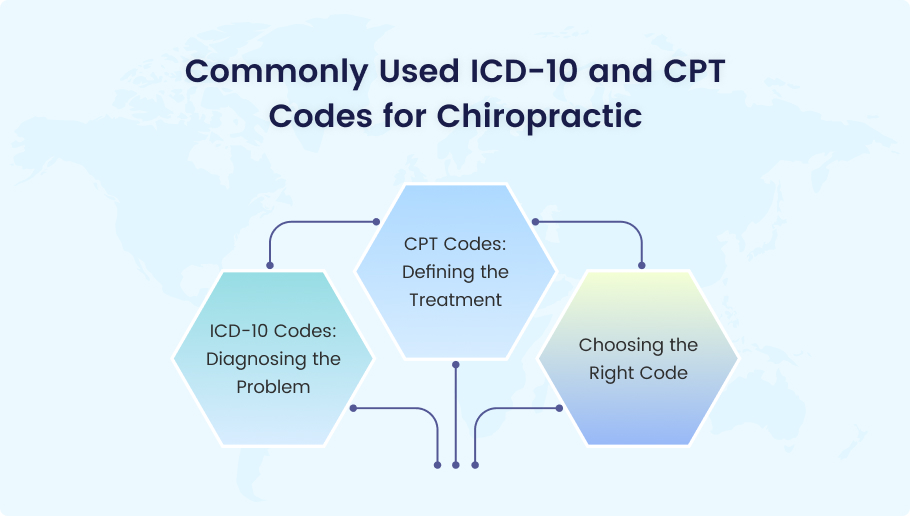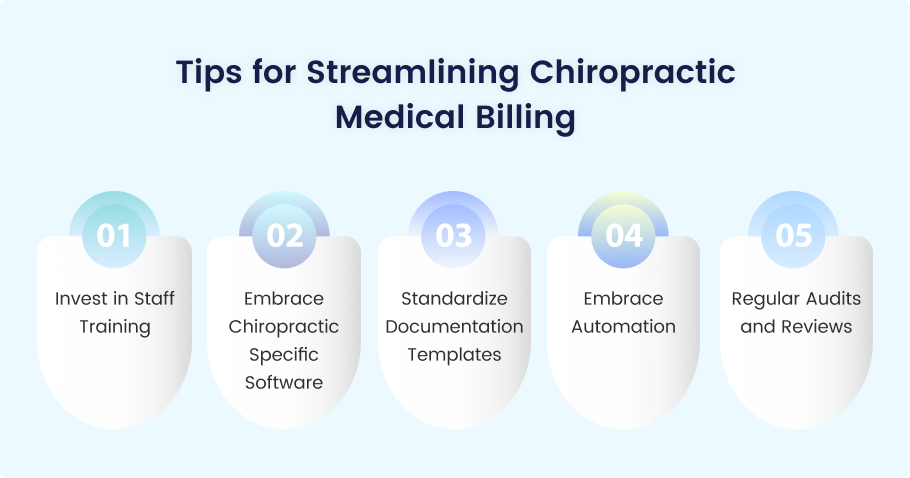
To run a successful chiropractic practice, one has to do more than just offer good patient care. It is equally important that your practice receives proper reimbursement for all the services rendered. This is where knowledge of chiropractic billing and coding is essential.
This detailed blog gives you the necessary information and ways to deal with this sometimes-complicated system. In this guide, we will be going through the basics of billing and coding, looking at the most commonly used codes, discussing the issues faced by chiropractic practices, and giving you some useful tips to make the process smoother.
Moreover, we will be discussing the advantages of outsourcing chiropractic billing to expert services that will enable you to make the right choices for the financial well-being of your practice.
In the realm of chiropractic care, accurate billing and coding for services is the link between your services and insurance companies. It’s a two-step process. Initially, you need to bill accurately by keeping all patient accounting records within a professional practice. This encompasses such information as the date of the service, diagnoses, chiropractic manipulations or therapies performed, etc. Concisely, this is helping you to keep track of the chiropractic services you have provided.
The next step is coding it into standardized codes that follow medical common language. There are two main coding systems used in chiropractic billing: The ICD-10 codes define your patients’ diagnoses, including their neck and back pains, while the CPT codes indicate the various chiropractic treatment options provided, including adjustment procedures or exercises. Through a precise description of your services and proper coding, you communicate to insurers the worth of your care and receive just compensation for proficient chiropractic skills.
Chiropractic billing and coding rely on two key sets of codes: ICD-10 and CPT codes. The accuracy of service delivered and maximized reimbursement for your chiropractic practice are all hinged upon a proper understanding of these codes.
ICD-10 Codes: Diagnosing the Problem
Some commonly used ICD-10 codes for chiropractic care include:
- M54.5: Low Back Pain
- M40: Dorsalgia (Pain in the upper back)
- M42: Cervicalgia (Neck pain)
- M75.1: Spondylosis (Degenerative changes in the spine)
- M25.0: Neuralgia and Neuritis (Nerve pain)
CPT Codes: Defining the Treatment
Here are some commonly used CPT codes for chiropractic services:
- 98940: Chiropractic Manipulative Treatment (CMT) of 1-2 spinal regions (This is a common code for spinal adjustments)
- 97110: Therapeutic Exercises
- 97012: Mechanical Traction Therapy
- 97530: Therapeutic Activities
- 97010: Hot/Cold Packs
Choosing the Right Code
Choosing the precise code for every service is a must. The specific code used depend on factors like:
- The spine’s region’s treatment
- The type of chiropractic manipulation performed
- Any additional therapies provided
Challenges for Chiropractic Medical Billing
Even though chiropractors considerably improve the quality of patients’ lives, getting through the billing process can be literally a pain in the neck for your practice. Here’s a closer look at the specific chiropractic billing challenges you might encounter:

Diagnosis is a Real Complication
In chiropractic, the diagnoses tend to be relatively complicated, with subluxations, facet syndromes, and myofascial pain syndromes being the most common ones. Correctly transforming them into the ICD-10 codes, which use standard medical terms, requires a deep understanding of both chiropractic and medical terminology.
Selecting the wrong code can result in a claim denial or under reimbursement for the unique chiropractic care you provided.
Chiropractic Plans are Specific
Unlike some medical specialties where treatment plans are more universal, chiropractic patients receive a personalized plan. Detailing your procedural plan, including which spinal regions are adjusted (cervical, thoracic, lumbar, or sacral) or the category of manipulation used (diversified, Gonstead, etc.), necessitates the use of accurate documentation and specific CPT codes.
Not including these elements can lead to an incomplete picture for insurance providers, so the claims can be dismissed.
Package Deals vs. A La Carte
Chiropractors usually apply the different treatment options, which often include adjustment with other techniques such as therapeutic exercises, electrical muscle stimulation, and/or hot/cold therapy. It is critical to learn how to properly portray these bundled services, as accurately coding them is essential.
Incorrect codes for combination therapies are generally going to be the reason for lost revenue for you or your organization.
Wellness vs. Treatment
Some health care plans may not be reimbursable for chiropractors in cases such as prevention and routine maintenance. It is vital to keep yourself apprised of insurance coverage guidelines in order to certify that the bills you send for services rendered to any particular patient are what are deemed medically necessary under his or her plan.
These restrictions, which are particular to the complexities of chiropractic care, can really affect the financial health of your practice. The encouraging thing is that there are options and tactics designed to make your life as a chiropractor easier.
In order to effectively manage a chiropractic clinic, there must be a delicate balance between the provision of excellent patient care and promoting financial success. Streamlining the bills of your process is the most important way to reach the balance. Here are some practical tips specifically designed to make chiropractic medical billing smoother and more efficient:
Invest in Staff Training
Build a strong knowledge base in your team on chiropractic coding and documentation rules and regulations. Ensure regular training for the staff is an integral part of the company routine to help them stay ahead of regulations that keep evolving.
Embrace Chiropractic-Specific Software
Get rid of standardized billing software. Invest in a system that was created only for billing in the chiropractic field. Such systems are usually implemented with predefined templates, and they can be used for typical chiropractic procedures and diagnoses, significantly reducing the risk of mistakes and saving time.
Standardize Documentation Templates
To lessen the challenges a medical caregiver may face during a patient encounter, have a standard and clear procedure for these visits. Such templates should hold all information that is essential for proper coding, which includes the names of certain diagnoses, treatment details (regions where it is adjusted, techniques being used), and any additional therapies.
Embrace Automation
Choose the automation option provided through your chiropractic billing software. Make sure that all aspects of your practice are covered. Develop automated systems for tasks such as form creations, eligibility verifications, and claim submissions. This will allow staff to free up for other immensely crucial functions.
Regular Audits and Reviews
Be sure to schedule internal auditing of your billing processes at regular time intervals. This preemptive approach is an effective tool as it detects any coding issues and document inconsistencies prior to the rejection of claims.
While the management of your chiropractic demands your attention to the patient care aspect, at the same time, it is also vitally important to ensure adequate reimbursement for your services. But it may take away from my time as a chiropractor to put effort into the billing and coding. Outsourcing your billing to reliable healthcare billing practitioners is a formidable rescue. They make sure to keep up with complicated coding rules and translate chiropractic diagnoses into accurate codes. It reduces claim denials and thus enhances payment. In addition, the staff can use their time to serve their patients, the cash flow can be increased, there is better reimbursement, and they have peace of mind with such experts handling denials and compliance.
Look at the option of partnering with an established medical billing provider such as MedHeave to ensure your chiropractic practice’s financial health is promoted. Their knowledge of medical billing and coding can guarantee correct claim submissions and claim reimbursement at the highest level. That means you can focus on the job, which is providing superior care for patients, while Medheave, in turn, brings about the essential things, such as billing, and improves the cash flow. Sign up today for error free Chiropractic billing services.











